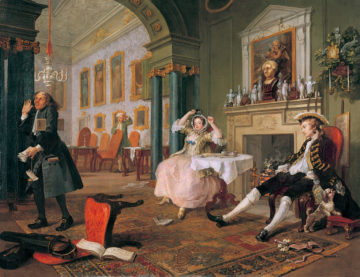
The title of Tate Britain’s latest exhibition, “Hogarth and Europe,” is slightly misleading. Setting out, as it does, to “suggest the cross currents, parallels and sympathies that crossed borders” during William Hogarth’s time, it more effectively makes clear some obvious cultural differences. Hogarth is celebrated for his social satires of eighteenth-century life but each time he is compared with a European contemporary—the curators have placed his works beside pieces from Amsterdam, Paris, Venice, and beyond—Hogarth only appears more bawdy, more biting, and more British.
Take, for example, the group of Venetian painters. Pietro Longhi may have elicited comparisons to Hogarth for his genre scenes, but The Painter in His Studio (ca. 1741–44), in which an artist paints an aristocratic young woman seated in his studio, feels like a straightforward portrayal of fashionable society and lacks the narrative vitality of Hogarth’s The Distressed Poet (1733–35).
more here.
